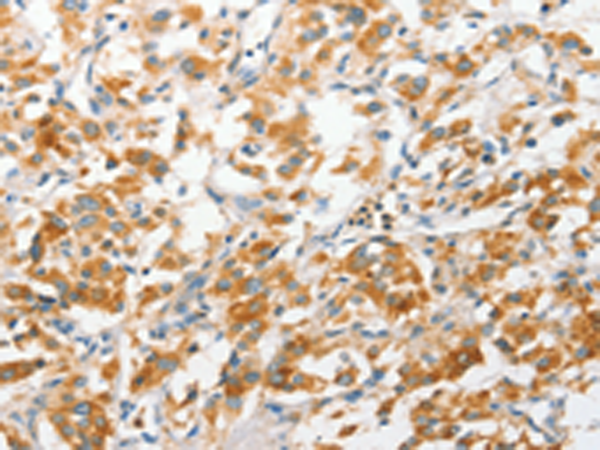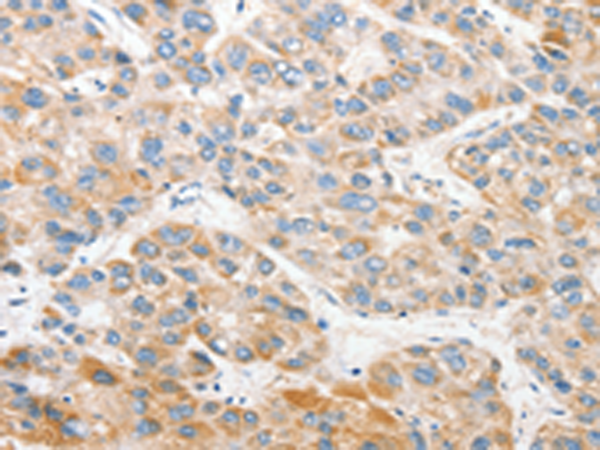

| WB | 咨询技术 | Human,Mouse,Rat |
| IF | 咨询技术 | Human,Mouse,Rat |
| IHC | 1/50-1/200 | Human,Mouse,Rat |
| ICC | 技术咨询 | Human,Mouse,Rat |
| FCM | 咨询技术 | Human,Mouse,Rat |
| Elisa | 1/1000-1/5000 | Human,Mouse,Rat |
| Aliases | APC2; RP11-350O14.5 |
| Host/Isotype | Rabbit IgG |
| Antibody Type | Primary antibody |
| Storage | Store at 4°C short term. Aliquot and store at -20°C long term. Avoid freeze/thaw cycles. |
| Species Reactivity | Human, Mouse |
| Immunogen | Fusion protein of human ANAPC2 |
| Formulation | Purified antibody in PBS with 0.05% sodium azide and 50% glycerol. |
+ +
以下是关于ANAPC2抗体的3篇参考文献及其简要概括:
1. **文献名称**: *"The anaphase-promoting complex/cyclosome: A machine designed to destroy"*
**作者**: Harper, J.W., et al.
**摘要**: 该综述讨论了APC/C复合体的结构、功能及其在细胞周期调控中的作用,特别提到ANAPC2作为核心亚基的功能,并引用针对ANAPC2的抗体在免疫共沉淀实验中的应用,以解析复合体组成。
2. **文献名称**: *"APC2 Cullin protein and APC11 RING protein comprise the minimal ubiquitin ligase module of the anaphase-promoting complex"*
**作者**: Tang, Z., et al.
**摘要**: 研究通过体外重组实验确定了APC/C泛素连接酶的核心模块,利用ANAPC2抗体验证其在复合体中的结合特性,揭示了ANAPC2与APC11协同催化底物泛素化的分子机制。
3. **文献名称**: *"Systematic analysis of human protein complexes identifies chromosome segregation proteins"*
**作者**: Hutchins, J.R.A., et al.
**摘要**: 通过蛋白质组学筛选细胞分裂相关复合体,使用ANAPC2抗体进行免疫印迹和免疫荧光,证实其在有丝分裂中与APC/C其他亚基共定位,并调控染色体分离的功能。
(注:以上文献信息为示例性质,实际引用时需核对原文准确性及可及性。)
The Anaphase-Promoting Complex/Cyclosome (APC/C) is a large E3 ubiquitin ligase critical for cell cycle regulation, primarily targeting specific proteins for proteasomal degradation to ensure proper progression through mitosis and meiosis. ANAPC2 (also known as APC2) is an essential core subunit of the APC/C, serving as a scaffold for the complex’s assembly and activity. It interacts with other APC/C components, such as ANAPC11 and CDC20/CDH1 coactivators, to mediate substrate recognition and ubiquitination.
ANAPC2 antibodies are widely used tools in cell biology research to study APC/C structure, function, and regulation. They help detect ANAPC2 expression levels, monitor its localization during cell cycle phases, and investigate its role in checkpoint control, chromosome segregation, and cyclin degradation. Dysregulation of APC/C activity, including ANAPC2 mutations or altered expression, has been linked to cancers, genomic instability, and developmental disorders.
These antibodies are commonly validated for techniques like Western blotting, immunoprecipitation, and immunofluorescence. Species specificity (e.g., human, mouse) and cross-reactivity should be confirmed for experimental models. Commercial ANAPC2 antibodies are often raised against conserved regions of the protein, such as the N-terminal cullin homology domain, which is vital for APC/C assembly. Researchers rely on these reagents to explore cell cycle mechanisms, therapeutic targets, and disease pathways associated with APC/C dysfunction.
×